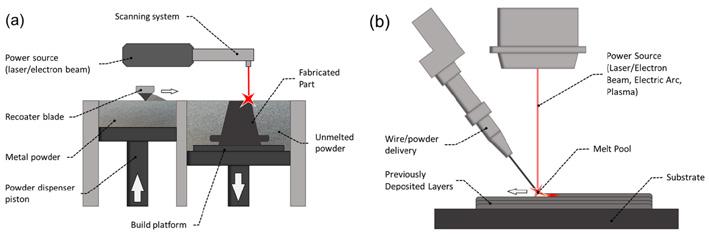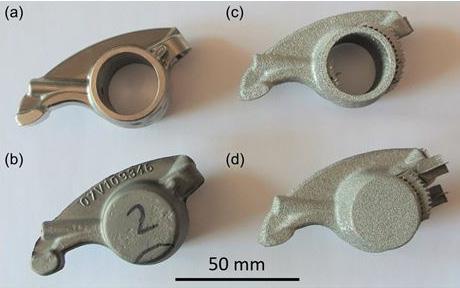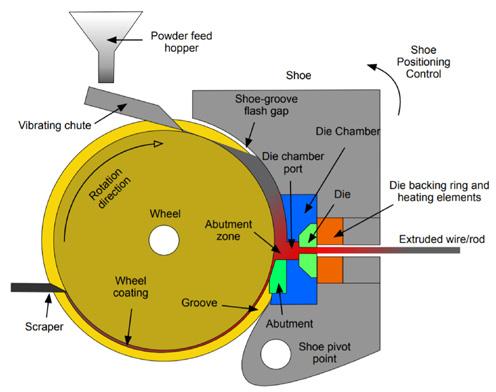
10 minute read
Near-Net Shape Manufacturing of Ti Alloy Parts From Powder and Wire: State-of-the-Art Process Routes
from Titanium Today: Promoting and supporting the use of titanium metal in new and existing applications.
By Thomas Childerhouse and Martin Jackson
(Editor’s note: The following article presents an overview of titanium manufacturing technology research work at the Department of Material Science and Engineering, the University of Sheffield, UK. The text is an abstract from a technical paper published in 2019 by the guest authors.)
Near-net shape (NNS) manufacturing offers an alternative to conventional processes for the manufacture of titanium alloy components. Compared to the conventional routes, which typically require extensive material removal of forged billets, NNS methods offer more efficient material usage and can significantly reduce machining requirements. Furthermore, NNS manufacturing processes offer benefits such as greater flexibility and reduced costs compared to conventional methods. Processes such as metal additive manufacturing (AM) have started to be adopted in niche applications, most notably for the manufacture of medical implants, where many conventionally forged components have been replaced by those manufactured by AM processes.
However, for more widespread adoption of these emerging processes, an improvement in the confidence in the techniques by manufacturers is necessary. This requires addressing challenges such as the limited mechanical properties of parts in their as-built condition compared to wrought products and the postprocess machining requirements of components manufactured by these routes. In this review, processes which use a powder or wire feedstock are evaluated to assess their capabilities for the manufacture of titanium alloy components. These processes include powder bed fusion and direct energy deposition metal additive processes as well as hybrid routes, which combine powder metallurgy with thermomechanical post-processing.
Conventional process routes for manufacturing titanium alloy components in the dominant aerospace sector typically involve extensive subtractive machining of forged billets. It is not uncommon for machining processes to remove 80–90 percent of the forging to achieve the final part dimensions, contributing up to 60 percent of a component’s manufacturing cost. Therefore, NNS manufacturing processes are emerging as alternative methods for the production of a range titanium alloy components.
There are currently a variety of NNS manufacturing processes available, which can be grouped in to the following families: metal additive manufacturing (AM) and hybrid processing routes. At present, these processes are at different levels of technology readiness, ranging from early developmental stages to being used for niche component manufacture.

This is a schematic representation of: (a) powder bed fusion; and (b) directed energy deposition metal additive manufacturing processes.
Additive Manufacturing Processes
Various metal AM methods exist that can be used for the manufacture of titanium alloy components. Compared to conventional processes, these methods offer benefits such as greater manufacturing flexibility, the ability to manufacture components with more complex geometries and hollow features, as well as greater control over the material properties. These benefits, as well as the advantage of the reduced requirement for material removal, makes metal AM an attractive option for many applications. Metal AM methods are often insufficient, however, for producing components with a high enough dimensional accuracy and surface finish quality for many applications and so post-process machining operations are usually required to produce the final component.
The most popular metal AM processes in applications using titanium alloys use either powder bed fusion (PBF) or directed energy deposition (DED) methods to build the component. Powder bed fusion methods use either a laser or electron beam power source to fuse particles of metal together, whereas directed energy deposition methods deposit a melted material feedstock through a nozzle onto a surface. This feedstock can consist of a powder, wire, or a combination of both. In applications where higher deposition rates are important, such as for the manufacture of larger components, DED methods are preferred due to the much slower build rates achievable with PBF. PBF methods, however, are advantageous in comparison to DED methods in their ability to manufacture parts with a better resolution and surface quality.
Limitations of Metal AM for Titanium Alloy Components
The main limitation of components produced by metal AM is a lack of knowledge of the mechanical properties for a given component. There are many parameters related to the build process, which influence the microstructure of the as-built material, and thus the mechanical properties of the component. Although properties such as the yield and ultimate tensile strength of AM Ti-6Al-4V, for example, are similar to those of wrought material, other properties, such as the fatigue strength and ductility of AM titanium alloys are often inferior to forged material and are typically more similar to those of cast material. Therefore, applications for titanium components built using metal AM are generally well suited for replacing cast components, rather than critical structural components, which require the superior mechanical properties achieved by the forging process.
Selective Electron Beam Melting (SEBM)
In SEBM, the laser beam energy source that is used for Selective Laser Melting (SLM) is replaced by that of an electron beam. Compared to SLM methods, somewhat higher build rates are achievable (up to 100 cm3/h compared to 70 cm3/h) and generally the process is capable of producing fully dense components with fewer defects compared to SLM. However, the surface finish of components produced by SEBM is considered to be of a lower quality. Compared to SLM, where rapid cooling rates induce displasive martensitic transformations from the phase, microstructures in SEBM titanium builds are dominated by diffusional transformations of elongated and far less in prior grains (in the case of Ti-6Al-4V). This is due to the slower cooling rates and the fact that the build is maintained at a higher temperature during the SEBM process. This is advantageous for the mechanical properties of components produced by SEBM, as lower levels of anisotropy and residual stress are typical, as the part is annealed during the process. For this reason, post-process heat treatments are generally not required for SEBM parts.
SEBM has been used as an alternative method to machining wrought Ti-6Al-4V material to produce a variety of brackets in a spacecraft application. In this application, parts were designed to have additional bulk to allow for machining of the as-built part in order to produce finished components which met the necessary tolerances. The SEBM/machining process route was found to offer various benefits compared to machining wrought material. These advantages included much reduced manufacturing lead times,which allowed for the manufacture of a number of complex designs and lower costs compared to the conventional route.
Like SLM processes, SEBM has similar capabilities in producing implants with the porosity and mechanical properties that mimic trabecular bone and also offers significant advantages compared to conventional manufacturing methods for these types of components.

Ti-6Al-4V valve train rocker arms were manufactured through the University of Sheffield by the following metal additive and hybrid powder metallurgy process routes: (a) FAST-forge with post-process finish machining; (b) FAST-forge; (c) SEBM metal additive; and (d) SEBM metal additive with additional machining stock. Victoria Forgings,Wolverhampton carried out the forging of the FAST-forge components (a and b).
Directed Energy Deposition (DED)
The DED process involves the delivery of either a wire or powder feedstock into a melt-pool on the surface of a substrate material. The feedstock melts and contributes to the volume of the pool. The component is then cladded layer by layer, as the melt-pool solidifies and the process is repeated on the newly built layer. Various DED technologies exist, which use different energy sources for melting the feedstock material. In the laser metal wire deposition LMD processes, highpower laser beams are used to provide the energy required to melt the substrate and feedstock material.
The beam is directed along the surface of the substrate to follow the path of the desired component’s cross-section. In LMD, the feedstock can consist of either a wire or powder, with wire being advantageous in terms of lower costs, ease of handling, and its ability to achieve higher deposition rates. Material delivery can be carried out by either a single nozzle or, alternatively, multiple nozzles can be used to combine different feedstock materials, such as different powders, or a combination of both powder and wire can be used. The use of combined feedstock materials offers the ability to achieve greater control over the properties of the built material by alloying materials in the melt pool, or can be used for the production of functionally graded components.
For SMD processes, wire feedstocks are used and the laser energy source is replaced by either electric arc welding or a plasma process. However, similar to LMD processes, the method of cladding a new layer of material upon a previously deposited layer remains the same. Compared to LMD, these methods offer less control over the thermal heat input to the feedstock and therefore are more prone to excess heat input leading to thermal distortion and oxidation of the material.
Wire-Fed Directed Energy Deposition
Compared to blown powder processes, wire fed processes are advantageous due to higher deposition rates and the expense of suitable wire is lower than titanium powders. One manufacturer who has adopted a wire-fed DED process in their manufacturing process is Norsk Titanium. Their process involves the implementation of a wire DED processes for the manufacture of a structural aerospace component used on the Boeing 787 Dreamliner. In this application, their Rapid Plasma DepositionTM process is used to build the part on a five-axis CNC machining center to produce the finished component.
Wire and Arc Additive Manufacturing (WAAM) is another technology which employs wire DED for the manufacture of large scale titanium alloy components. The process, which is being developed in the United Kingdom by Cranfield University, uses an electric arc heat source and has been used to manufacture a variety of NNS parts such as the Ti-6Al-4V landing gear. The material saving benefits of metal AM are most significant when manufacturing large scale components.
Hybrid Processing Routes
Hybrid processing routes combine NNS manufacturing processes with an additional process step whereby preforms manufactured by a NNS process are deformed to enhance the mechanical properties of the material. The processes considered in this review achieve the deformation process by a single-step hot forging operation. This process is able to improve both the toughness and fatigue properties by grain refinement and porosity reduction.
The FAST-forge process is a two-step solid-state hybrid manufacturing route being developed by The University of Sheffield and partners for the production of NNS titanium alloy components. The initial step uses shaped field assisted sintering to consolidate titanium powder into a pre-forged billet. This is then followed by the second step, in which the FAST billet is then closed-die hot forged to achieve a NNS part geometry. This forging step improves the mechanical properties of the FAST titanium by refinement of the microstructure and allows for components to be manufactured with properties similar to those of conventional wrought products.

This is a schematic representation of the Conform™ process for titanium alloy wire rod production direct from powder, particulate, or waste product, such as machining swarf.
Conclusions
This review evaluates a selection of emerging NNS manufacturing processes suitable for the manufacture of titanium alloy components. Compared to conventional manufacturing routes, these processes can produce more cost effective NNS titanium alloy components with more efficient material utilization. The review considers processes such as powder bed fusion and directed energy deposition AM processes, as well as hybrid processing routes. A comparison between the merits and challenges of each of these techniques is given, which suggests that powder bed fusion processes such as SLM and SEBM are well suited for the production of smaller, highly geometrically complex components such as medical implants. Conversely, direct energy deposition processes show more promise for the manufacture of larger scale components and have the potential to become more widely adopted for the manufacture of aerospace structures.
It is evident that, compared to wrought components, AM processes are less capable of producing components with the mechanical properties required in structurally critical applications. Issues such as the directional dependence of mechanical properties, as well as the poorer ductility and fatigue strength of AM, compared to wrought material, have influenced the use of postprocess heat treatments and HIP of the as-built material. These have shown to be effective in alleviating some of these detrimental properties. Hybrid processing routes take post-processing of AM parts further, incorporating a hot forging step. This offers a potentially new method to manufacture high strength titanium aerospace structures which can compete with those only currently achievable by conventional forging processes.
(About the guest authors: As an engineering doctoral student based at the Department of Materials Science and Engineering at the University of Sheffield, UK, Thomas Childerhouse’s research focuses on downstream finish machining processes for titanium alloy components processed by emerging near net-shape routes. Martin Jackson is professor of advanced metals processing at the University of Sheffield and Henry Royce Institute. He is the UK representative on the Titanium Conference International Organization Committee and Chair of the 15th World Conference on Titanium in Edinburgh 2023. For more information on the research work, visit the university’s website: www.sheffield. ac.uk/materials.)







